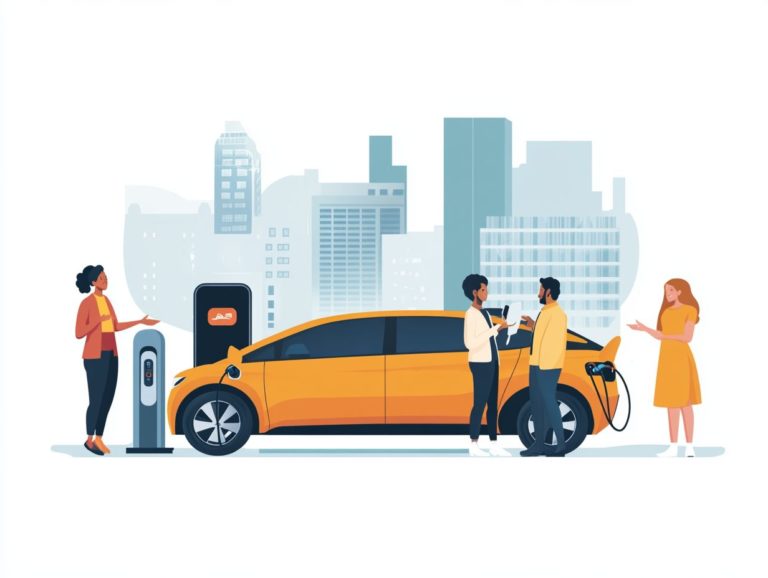5 Electric Vehicle Trends to Watch This Year
As the automotive landscape evolves, you ll find electric vehicles (EVs) leading the charge in innovation and sustainability. This year is set to unveil exciting trends that will sculpt the future of transportation, from the remarkable uptick in EV sales to the expansion of charging infrastructure.
With new models entering the market and advancements in battery technology, you have the opportunity to explore the myriad benefits and challenges associated with going electric. Let s delve into five key trends that could transform how you drive and engage with your surroundings.
Contents
- Key Takeaways:
- 1. Increase in Electric Vehicle Sales
- 2. Expansion of Charging Infrastructure
- 4. Government Incentives and Regulations
- 5. Advancements in Battery Technology
- What Are the Benefits of Electric Vehicles?
- Frequently Asked Questions
- What are the top 5 electric vehicle trends to watch this year?
- How will electric vehicle range improve this year?
- What is fast-charging technology and how will it impact electric vehicles this year?
- Are there any electric vehicle options that are more affordable now?
- How is the government supporting the growth of electric vehicles?
- Will we see more self-driving electric cars on the road this year?
Key Takeaways:

1. Increase in Electric Vehicle Sales
Electric vehicle sales are booming! This trend is fueled by your desire for cleaner transportation and advancements in electric vehicle technology.
Major brands like Tesla, along with newcomers like VinFast and BYD, are leading the charge. They re capturing significant market shares in Europe, the U.S., and China.
Global electric vehicle registrations jumped by over 50% last year. This surge is thanks to stricter emission laws and attractive incentives for buyers.
As cities expand their charging networks, the appeal of EVs increases. This shift aligns with a global movement toward sustainable living.
2. Expansion of Charging Infrastructure
Charging infrastructure is key to making electric vehicle ownership convenient. It boosts your confidence in choosing electric mobility.
You ll find many types of charging stations fast chargers on highways and slow chargers in neighborhoods. These options fit your travel habits.
Even rural areas are improving access to charging stations thanks to government efforts. This brings equity to EV ownership.
Local and federal policies are important in encouraging private investments for infrastructure. These improvements help ease range anxiety, making EV ownership practical for more people.
4. Government Incentives and Regulations
Government incentives and regulations are crucial in accelerating your transition to electric cars. They shape the landscape for electric vehicle sales and adoption globally through various subsidies and supportive policies.
In places like China, Europe, and the United States, these incentives manifest in diverse ways. They span tax credits, rebates, and financial support for charging infrastructure all designed to ease the upfront costs of owning an electric vehicle. This unique blend of policies creates a more favorable purchasing environment while compelling automakers to adjust their production strategies to cater to the rising demand for electric vehicles.
For example, in Europe, ambitious carbon reduction targets push manufacturers to invest significantly in electric vehicle (EV) technology. In the U.S., state-level initiatives create a patchwork of benefits that greatly influence your consumer choices across different markets.
5. Advancements in Battery Technology

Advancements in battery technology are leading the charge in the electric vehicle industry. They significantly improve performance, range, and affordability, igniting consumer interest and fostering widespread adoption.
Recent breakthroughs, especially in lithium-ion batteries commonly used in electronics for their efficiency and quick charging and solid-state batteries promise even greater energy density and enhanced safety. Lithium-ion batteries feature faster charging times and longer lifespans, helping to reduce production costs for manufacturers.
These innovations not only expand the driving range of electric vehicles but also bring prices down for consumers. As these technologies continue to advance, they herald a future where electric mobility becomes more accessible and prevalent globally.
What Are the Benefits of Electric Vehicles?
Electric vehicles offer an exciting array of benefits that extend far beyond mere personal convenience. They play a crucial role in enhancing environmental sustainability, decreasing reliance on fossil fuels, and driving innovations in clean technology, making them a compelling option for consumers and businesses alike.
It s not just their eco-friendly attributes that stand out. Electric vehicles (EVs) also boast significantly lower operating costs. You could save thousands of dollars over the vehicle’s lifespan, especially on fuel and maintenance expenses. The U.S. Department of Energy indicates that EVs can save an average of $800 per year on fuel alone compared to traditional gasoline vehicles.
As more households and businesses embrace this technology, energy independence receives a substantial boost. Transitioning to electricity derived from renewable resources can notably reduce dependence on imported oil. A case study from San Diego illustrates this; the city achieved a remarkable 25% reduction in greenhouse gas emissions by implementing electric fleets.
These examples illustrate the concrete, positive impacts that EVs can have on urban environments and broader sustainability objectives.
What Are the Challenges of Electric Vehicles?
Despite the numerous advantages, transitioning to electric vehicles presents its own set of challenges. You might be concerned about the charging infrastructure, the limitations of battery technology, and overall EV adoption rates.
Range anxiety can be a real struggle, as you may fear running out of power during longer trips. Manufacturers are working to establish a comprehensive network of charging stations that are both accessible and efficient.
Economic factors add another layer of complexity; the upfront costs along with fluctuating incentives can make potential buyers hesitant to make the switch.
Fortunately, various stakeholders governments and private companies are diligently working to expand charging networks, enhance battery technology, and offer financial incentives. Their efforts aim to address these challenges and pave the way for a more sustainable automotive future.
Are you ready to join the electric vehicle revolution? Discover how making the switch to an electric vehicle can benefit you today!
What Are the Different Types of Electric Vehicles?
Electric vehicles come in various forms, including battery electric cars and plug-in hybrids. Each type is designed to meet specific consumer needs and preferences in electric mobility.
Battery electric vehicles (BEVs) run solely on electric power stored in their high-capacity batteries. This means you can enjoy zero-emission driving and often lower operating costs. They are ideal for daily commutes or urban driving, especially where charging infrastructure is readily available.
On the other hand, plug-in hybrids combine a gasoline engine with an electric motor. This gives you more flexibility, especially for longer trips when charging may not be feasible.
While BEVs excel in efficiency and eco-friendliness, plug-in hybrids provide the advantage of not being tied to charging stations. This makes them particularly attractive if you re worried about range anxiety. Understanding these differences allows you to make informed choices based on your driving habits and environmental priorities.
How Can Businesses Incorporate Electric Vehicles into Their Operations?

You can successfully incorporate electric vehicles into your business by tapping into the growing demand for sustainable transport. Align your strategies with electric vehicle management.
By exploring various pathways like fleet electrification, you can reduce operational costs over time while enhancing your corporate image. Conducting thorough cost-benefit analyses will help you weigh initial investments against potential savings. Many organizations find that EV subsidies can significantly ease financial burdens.
Companies such as Amazon and UPS are leading the way by implementing comprehensive electric fleet strategies and showing impressive reductions in emissions. Their success makes a strong case for you to consider similar initiatives.
As the landscape changes, it s essential to stay updated on technological advancements and regulatory changes to ensure a smooth transition.
What Are the Environmental Impacts of Electric Vehicles?
The environmental impacts of electric vehicles are overwhelmingly positive. They significantly reduce greenhouse gas emissions and contribute to a more sustainable future when paired with clean technology.
To understand their benefits, consider their entire lifecycle from the extraction of raw materials for battery production to potential end-of-life disposal challenges. This contrasts sharply with traditional gasoline vehicles, which not only emit harmful pollutants during operation but also carry considerable environmental costs linked to fossil fuel extraction and processing.
Clean technology plays a vital role here. Advancements in battery recycling and renewable energy production can greatly reduce the ecological footprint. Transitioning to electric vehicles underscores the importance of a circular economy, where sustainability is a priority at every stage, enhancing their overall positive impact.
What Are the Predictions for the Future of Electric Vehicles?
Predictions for the future of electric vehicles indicate significant growth and remarkable technological advancements. This shift is driven by an expanding market share, evolving consumer preferences, and substantial investments from both private and public sectors, including emerging trends in EV charging technology.
As manufacturers adopt cutting-edge innovations like solid-state batteries and improved self-driving features, more consumers are leaning towards eco-friendly alternatives. The emerging trends in electric vehicle technology, along with the changing urban landscapes and expansion of charging infrastructure, are set to alleviate range anxiety, making it easier for you to consider an electric vehicle.
Government policies, including incentives for EV purchases and stricter emissions regulations, will be crucial in this transformation. Together, these trends create a promising outlook for the electric vehicle market, where sustainability and dynamic innovation come together, ultimately reshaping transportation for everyone. Understanding the factors driving electric vehicle adoption is key to navigating this change.
Frequently Asked Questions
What are the top 5 electric vehicle trends to watch this year?

The top 5 electric vehicle trends to watch this year are: increased range, fast-charging technology, more affordable options, increased government support, and the rise of self-driving electric cars.
How will electric vehicle range improve this year?
Electric vehicle range is expected to improve this year due to advancements in battery technology. These innovations will allow for longer-lasting and more efficient batteries, making it an exciting time to explore the top upcoming electric vehicles to watch.
This will eliminate range anxiety the fear that a vehicle won’t have enough power to reach its destination and make electric vehicles a more viable option for longer distance travel.
What is fast-charging technology and how will it impact electric vehicles this year?
Fast-charging technology allows for quicker charging times for electric vehicles, which means drivers can fill up their car batteries faster.
This breakthrough will make electric vehicles a game-changer for drivers, as they will have less downtime while waiting for their car to charge.
Are there any electric vehicle options that are more affordable now?
Yes, there are more affordable electric vehicle options available now. With advancements in technology and production processes, electric vehicles have become more cost-effective to manufacture.
This has resulted in more affordable options for consumers.
How is the government supporting the growth of electric vehicles?
Governments globally are implementing policies and incentives to support electric vehicle growth. This includes tax credits, subsidies, and infrastructure development such as charging stations.
These measures make it easier for consumers to switch to electric vehicles.
Will we see more self-driving electric cars on the road this year?
Yes, the rise of self-driving electric cars is a trend to watch this year. In particular, keep an eye on innovative EV startups because self-driving electric cars are hitting the streets sooner than you think!
With advancements in technology, many car manufacturers are investing in and developing autonomous electric vehicles, including those in emerging markets for electric vehicles, which offer a combination of sustainability and convenience.






